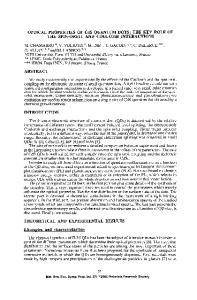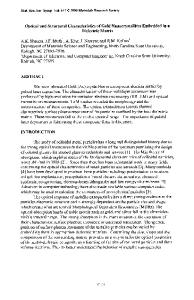Optical Interactions and Photoluminescence Properties of Wide-Bandgap Nanocrystallites
- PDF / 1,913,785 Bytes
- 6 Pages / 612 x 792 pts (letter) Page_size
- 12 Downloads / 276 Views
N11.17.1
Optical Interactions and Photoluminescence Properties of Wide-Bandgap Nanocrystallites Leah Bergman, Xiang-Bai Chen, Jesse Huso, Althea Walker, John L. Morrison, Heather Hoeck, and Margaret K. Penner. Department of Physics, University of Idaho, Moscow, ID 83844-0903 Andrew P. Purdy US Naval Research Laboratory, Chemistry Division, Washington DC 20375 Abstract The UV-photoluminescence (PL) properties of GaN and ZnO nanocrystallites and nanocrystallite ensembles were studied utilizing micro-photoluminescence. We address the origin of the light emissions of the nanocrystallite as to whether it is due a bandgap or excitonic recombination process. The other topic presented here focuses on the interaction of the laser with a collective of crystallites; we address the phenomena of intensity saturation at a high density of laser excitations as well as the impact of the vacuum state on the PL characteristics. Our analysis indicates that the PL of both GaN and ZnO nanocrysallites is excitonic-like and very similar to the behavior of the free exciton in bulk materials. Additionally, we attribute the intensity saturation of GaN and ZnO to the laser heating and heat trapping which takes place in the enclosure of the nanocrystallite ensemble. In vacuum the PL energy was found to exhibit a strong PL energy redshift relative to the PL in air. We attribute the observed shift to a thermal effect and analyze it in terms of the conditions enabling a convective cooling in the ensemble: the mean free path of air in atmospheric pressure and in vacuum relative to the interparticle separation inside the ensemble. Introduction GaN, due to its wide band gap ~ 3.5 eV and the ability to grow superb quality material, is one of the most promising materials for applications in blue light emitting diodes as well as lasers, high-speed field effect transistors, and high temperature and high frequency electronic devices [1]. Another highly promising wide bandgap material is ZnO of bandgap ~ 3.3 eV. ZnO has attracted interest as a blue light emitting material [2-3], a substrate for GaN-based devices [4], and a transparent conductor in solar cells [5-6]. Recent efforts have expanded investigation into the field of GaN and ZnO nanostructures including nanowires, nanorods, and various submicron powders. These structures can potentially be utilized for applications that involve high density, ultra-lightweight, and cost effective optical devices [7-11]. For such applications knowledge concerning the optical properties of light emission such as the underlying recombination mechanism of the PL and the PL efficiency, as well as the factors affecting these properties, is crucial to the realization of optical nanodevices. Our previous results concerning the optical properties of GaN nanocrystallites showed that when the crystallites were grouped in a relatively large and semi-compact ensemble (of size ~ 2-30 µm diameter and average porosity ~ 200 nm), the PL peak position exhibits a significant redshift accompanied by a line broadening; however, no maj
Data Loading...







